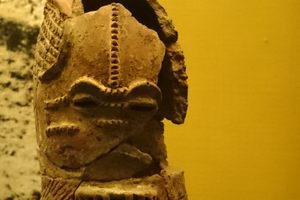
In the early 1960s, 16-year-old Karl-Ludwig von Bezing stumbled across some odd pottery fragments poking out from the soil on his family's farm in South Africa. As an amateur geologist and archaeologist, the young man's curiosity was piqued. Between 1962 and 1964, Von Bezing went on to excavate and collect what eventually were identified as the oldest African Iron Age artworks from south of the equator.
Once reconstructed at the University of Cape Town, a total of seven ceramic heads were found. Thought to be ceremonial objects for rites of passage, two of the heads are large enough to be worn over a human head. Each one sparkles in the sunlight, thanks to the use of specularite, a mineral which causes them to glimmer under sunlight. Each head is unique, decorated with both human and animal features.
The heads have been dated back to the year 490, when Bantu farmers and pastoralists occupied the area. Anthropologists believe they would have been made by the women of the community since pottery was traditionally a female activity among the Bantu, while men would have been metallurgists during this early Iron Age period. Some have speculated that the heads were ritualistically destroyed at the end of an okuyi ceremony, celebrating a boy’s transition to manhood, but their actual purpose is still uncertain.
Today, the original heads can be viewed at the Iziko South African Museum in Cape Town. Von Bezing went on to have a celebrated career in the Kimberley region as a radiologist, artist, and geologist. A new mineral called vonbezingite was even named in his honor. Still, his discovery of the Lydenburg heads is considered his crowning achievement.

Post a Comment